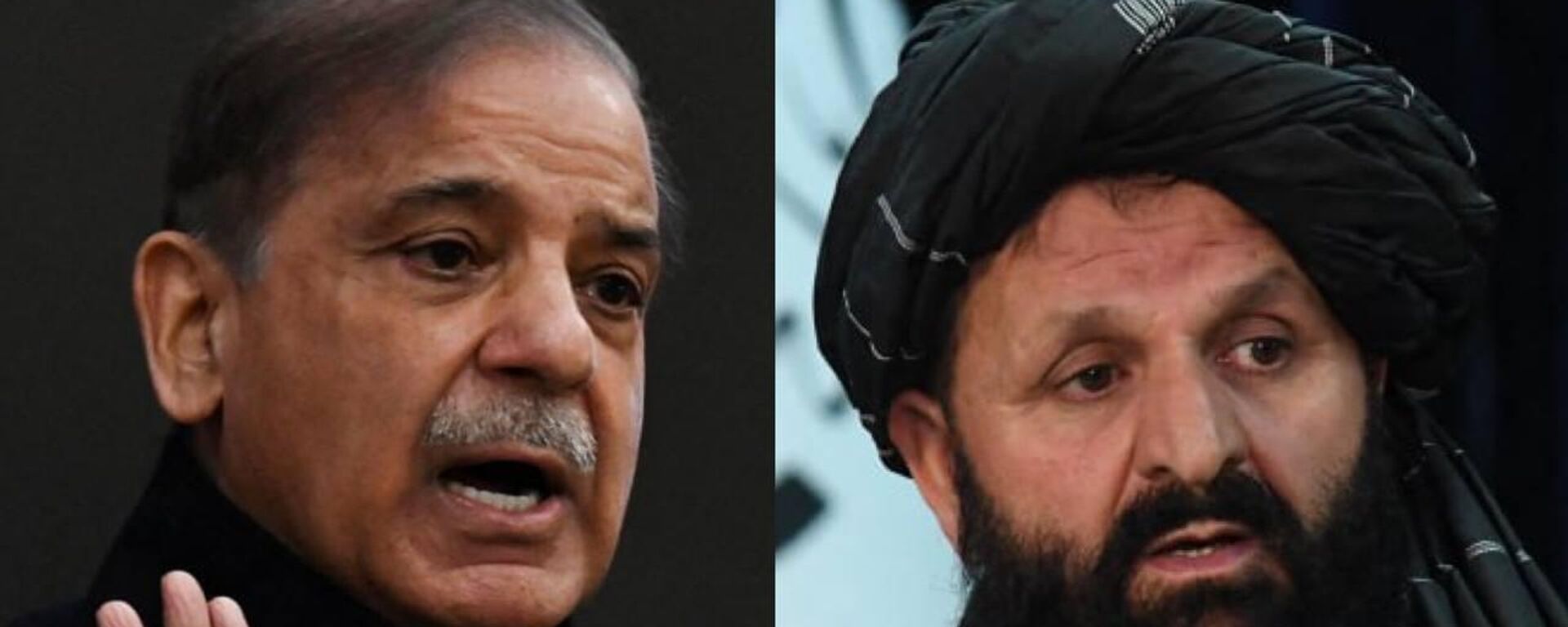https://sputniknews.in/20240814/understanding-the-durand-lines-role-in-afghan-pak-border-clashes-8012896.html
Understanding the Durand Line’s Role in Afghan-Pak Border Clashes
Understanding the Durand Line’s Role in Afghan-Pak Border Clashes
Sputnik India
The recent rift along the Durand Line, or the Torkham border as such, has more to do with the deep deterioration in Taliban-Pakistan ties, say strategic affairs experts.
2024-08-14T16:11+0530
2024-08-14T16:11+0530
2024-08-14T16:11+0530
sputnik opinion
pakistan
afghanistan
durand line
taliban
tehreek-e-taliban pakistan (ttp)
khyber pakhtunkhwa
kabul
islamabad
torkham border
https://cdn1.img.sputniknews.in/img/07e8/02/10/6578580_0:160:3072:1888_1920x0_80_0_0_ae19ac26079e767bc20a856fa88654a2.jpg
The recent rift along the Durand Line, or the Torkham border as such, has more to do with the deep deterioration in Taliban-Pakistan ties, say strategic affairs experts.On Monday, Pakistani and Afghan border guards traded gunfire, resulting in the deaths of three civilians in Afghanistan.The recent shooting on the Torkham border point has brought things, yet again, to a grinding halt, Dr. Priyanka Singh, an associate fellow at India's premier national security think tank, the Manohar Parrikar Institute for Defence Studies and Analyses (MP-IDSA), told Sputnik India on Wednesday.Torkham, located in the city of the same name in the northwestern Pakistani province of Khyber Pakhtunkhwa, is a major crossing point between Pakistan and Afghanistan.Moreover, the deteriorating situation can be attributed to several factors. The Taliban's* resistance to curbing the activities of the Tehreek-e-Taliban Pakistan (TTP**), coupled with Pakistan's efforts to expel Afghan refugees from its territory, has significantly deepened the divide between the two sides, according to the think tank analyst.Pakistan has insisted on its version of the Durand Line and has completed fencing alongside it to prevent uncontrolled and unfettered movement across the border, she pointed out.It must be understood that Pakistan's decision to erect a fence along the Durand Line has to do with its security imperatives as well as its desire to thwart unwanted migration or movement from across the Afghan side, according to the expert.In the meantime, relations between Pakistan and Afghanistan have remained strained. Currently, the situation stands in stark contrast to the joviality that was evident during the US withdrawal in August 2021.Singh believes that the atmosphere is too charged for the two sides to come together and resolve a decades-old issue that, more importantly, involves highly emotional and prestigious matters of territory and control.Meanwhile, Shahzad Masood Roomi, a Lahore-based geopolitics commentator, attributes the current border conflict between Kabul and Islamabad to Britain's infamous "divide and rule" policy.He expressed the view that, following Pakistan's fencing efforts, the conflict has manifestly escalated into a physical confrontation along the border.However, he asserted that the recent clashes between the two countries are unrelated to Afghanistan's claims regarding the Durand Line.Conversely, Syed Khalid Muhammad, the Executive Director of CommandEleven—a Pakistani think tank located in the garrison city of Rawalpindi—has stated that the Durand Line serves as a political assertion that has long been employed to reject the legitimacy of the international border.Khalid Muhammad noted that Afghans, for decades, used the drug and arms smuggling routes to cross into Pakistan without passports or immigration issues.It is a fallacy to believe their narrative about the Durand Line, especially when numerous times various Afghan armies have attempted to invade Pakistan's FATA to eliminate the border, but each time they failed and were sent back to Afghanistan, the expert underlined.He explained that the border issue impacts two groups: first, the Pashtuns who have families in the merged FATA region, and second, the terrorists who are infiltrating Pakistan. These terrorists cut through the border fence and use cover fire from the Taliban to engage Pakistan's security forces. This tactic enables them to infiltrate the region and reach their predetermined safe havens in South and North Waziristan, Bajaur, and Khyber Agency.*under UN sanctions for extremism.**terrorist organization banned in Russia and other states.
https://sputniknews.in/20240722/from-allies-to-adversaries-the-evolving-dynamics-of-ttp-taliban-and-pakistan-7881374.html
pakistan
afghanistan
durand line
khyber pakhtunkhwa
kabul
islamabad
torkham border
afghanistan-pakistan border
Sputnik India
feedback.hindi@sputniknews.com
+74956456601
MIA „Rossiya Segodnya“
2024
Pawan Atri
https://cdn1.img.sputniknews.in/img/07e6/0c/13/139630_147:0:831:684_100x100_80_0_0_8fa2b25903e7787fe6a2698552c167df.png
Pawan Atri
https://cdn1.img.sputniknews.in/img/07e6/0c/13/139630_147:0:831:684_100x100_80_0_0_8fa2b25903e7787fe6a2698552c167df.png
News
en_IN
Sputnik India
feedback.hindi@sputniknews.com
+74956456601
MIA „Rossiya Segodnya“
Sputnik India
feedback.hindi@sputniknews.com
+74956456601
MIA „Rossiya Segodnya“
Pawan Atri
https://cdn1.img.sputniknews.in/img/07e6/0c/13/139630_147:0:831:684_100x100_80_0_0_8fa2b25903e7787fe6a2698552c167df.png
durand line, torkham border, afghanistan pakistan border clashes, pakistan afghanistan border clashes, pashtunistan movement, history of durand line, durand line dispute, what is durand line?, durand line history, durand line british, durand line british colonial rule, afghan taliban durand line, afghanistan durand line, pakistan durand line,
durand line, torkham border, afghanistan pakistan border clashes, pakistan afghanistan border clashes, pashtunistan movement, history of durand line, durand line dispute, what is durand line?, durand line history, durand line british, durand line british colonial rule, afghan taliban durand line, afghanistan durand line, pakistan durand line,
Understanding the Durand Line’s Role in Afghan-Pak Border Clashes
The Durand Line, the de-facto border between Afghanistan and Pakistan, a legacy of British colonial rule, having been drawn by then-British diplomat Mortimer Durand in 1893, when Pakistan was part of the British Indian Empire. Notably, Afghanistan never recognised the division, making it a contentious issue between the two nations even now.
The recent rift along the Durand Line, or the Torkham border as such, has more to do with the deep deterioration in Taliban-Pakistan ties, say strategic affairs experts.
On Monday, Pakistani and Afghan border guards traded gunfire, resulting in the deaths of three civilians in Afghanistan.
"The Pakistani forces targeted civilian homes, killing a woman and two children," Mufti Abdul Mateen Qani, spokesman for Afghanistan's Interior Ministry, said.
The recent shooting on the Torkham border point has brought things, yet again, to a grinding halt,
Dr. Priyanka Singh, an associate fellow at India's
premier national security think tank, the Manohar Parrikar Institute for Defence Studies and Analyses (MP-IDSA), told Sputnik India on Wednesday.
Torkham, located in the city of the same name in the northwestern Pakistani province of Khyber Pakhtunkhwa, is a major crossing point between Pakistan and Afghanistan.
"The conflictual matrix concerning the Torkham border is rooted in the contested interpretation of what each country perceives as the border. The Durand Line cuts through the Pashtun belt in both countries and features contiguity in terms of ethnicity, culture and identity. Notably, the Pashtunistan movement is also constructed based on the commonalities across both sides of the Durand," Singh, who specialises in Afghan-Pakistan affairs, said.
Moreover, the deteriorating situation can be attributed to several factors. The Taliban's* resistance to curbing the activities of the Tehreek-e-Taliban Pakistan (TTP**), coupled with Pakistan's efforts to expel Afghan refugees from its territory, has significantly deepened the divide between the two sides, according to the think tank analyst.
Pakistan has insisted on its version of the Durand Line and has completed fencing alongside it to prevent uncontrolled and unfettered
movement across the border, she pointed out.
It must be understood that Pakistan's decision to erect a fence along the Durand Line has to do with its security imperatives as well as its desire to thwart unwanted migration or movement from across the Afghan side, according to the expert.
"The completion of the fencing along the Durand was considered one of the biggest achievements of former Pakistan Army chief General Qamar Javed Bajwa. Afghanistan, on the other hand, is incensed as it sees fencing as a concretisation of Pakistan's version of the Durand. Kabul perhaps is not ready to reconcile with this reality," Singh elaborated.
In the meantime, relations between Pakistan and Afghanistan have remained strained. Currently, the situation stands in stark contrast to the joviality that was evident during the US withdrawal in August 2021.
Singh believes that the atmosphere is too charged for the two sides to come together and resolve
a decades-old issue that, more importantly, involves
highly emotional and prestigious matters of territory and control.
Meanwhile, Shahzad Masood Roomi, a Lahore-based geopolitics commentator, attributes the current border conflict between Kabul and Islamabad to Britain's infamous "divide and rule" policy.
"However, as Afghanistan is a tribal state, not all the tribes agreed to this demarcation in the 19th century, especially those who had families on both sides of this border. After 1947, this conflict became a Pakistan-Afghan conflict where the Afghan side claimed that all the lands located on the west side of the Indus were part of Afghanistan," Roomi said in a conversation with Sputnik India.
He expressed the view that, following Pakistan's fencing efforts, the conflict has
manifestly escalated into a physical confrontation along the border.
However, he asserted that the recent clashes between the two countries are unrelated to Afghanistan's claims regarding the Durand Line.
"It is part of a larger realpolitik taking shape in the world," Roomi remarked.
Conversely, Syed Khalid Muhammad, the Executive Director of CommandEleven—a Pakistani think tank located in the garrison city of Rawalpindi—has stated that the Durand Line serves as a political assertion that has long been employed to reject the legitimacy of the international border.
"What we find sad is that the Afghan people as a whole don't have a problem with the border, it's the Pashtun population that has a problem. They contend that they have family on the Pakistan side of the border and due to the visa restrictions and the border fencing that was done to keep terrorists out of Pakistan, they are unable to easily meet them, which is wholeheartedly untrue," he stressed.
Khalid Muhammad noted that Afghans, for decades, used the drug and arms smuggling routes to cross into Pakistan without passports or immigration issues.
It is a fallacy to believe their narrative about the Durand Line, especially when numerous times various Afghan armies
have attempted to invade Pakistan's
FATA to eliminate the border, but each time they failed and were sent back to Afghanistan, the expert underlined.
He explained that the border issue impacts two groups: first, the Pashtuns who have families in the merged FATA region, and second, the terrorists who are infiltrating Pakistan. These terrorists cut through the border fence and use cover fire from the Taliban to engage Pakistan's security forces. This tactic enables them to infiltrate the region and reach their predetermined safe havens in South and North Waziristan, Bajaur, and Khyber Agency.
*under UN sanctions for extremism.
**terrorist organization banned in Russia and other states.



